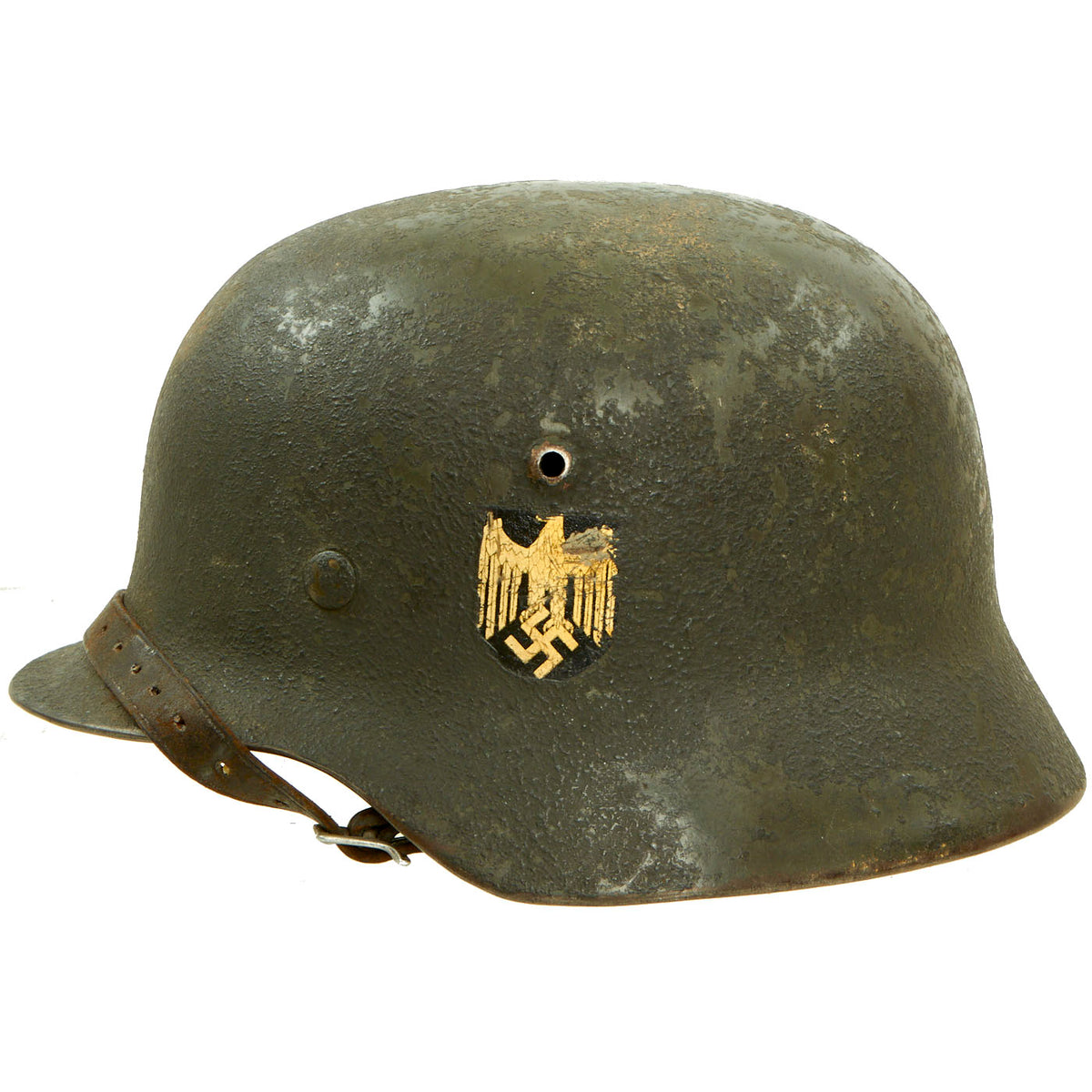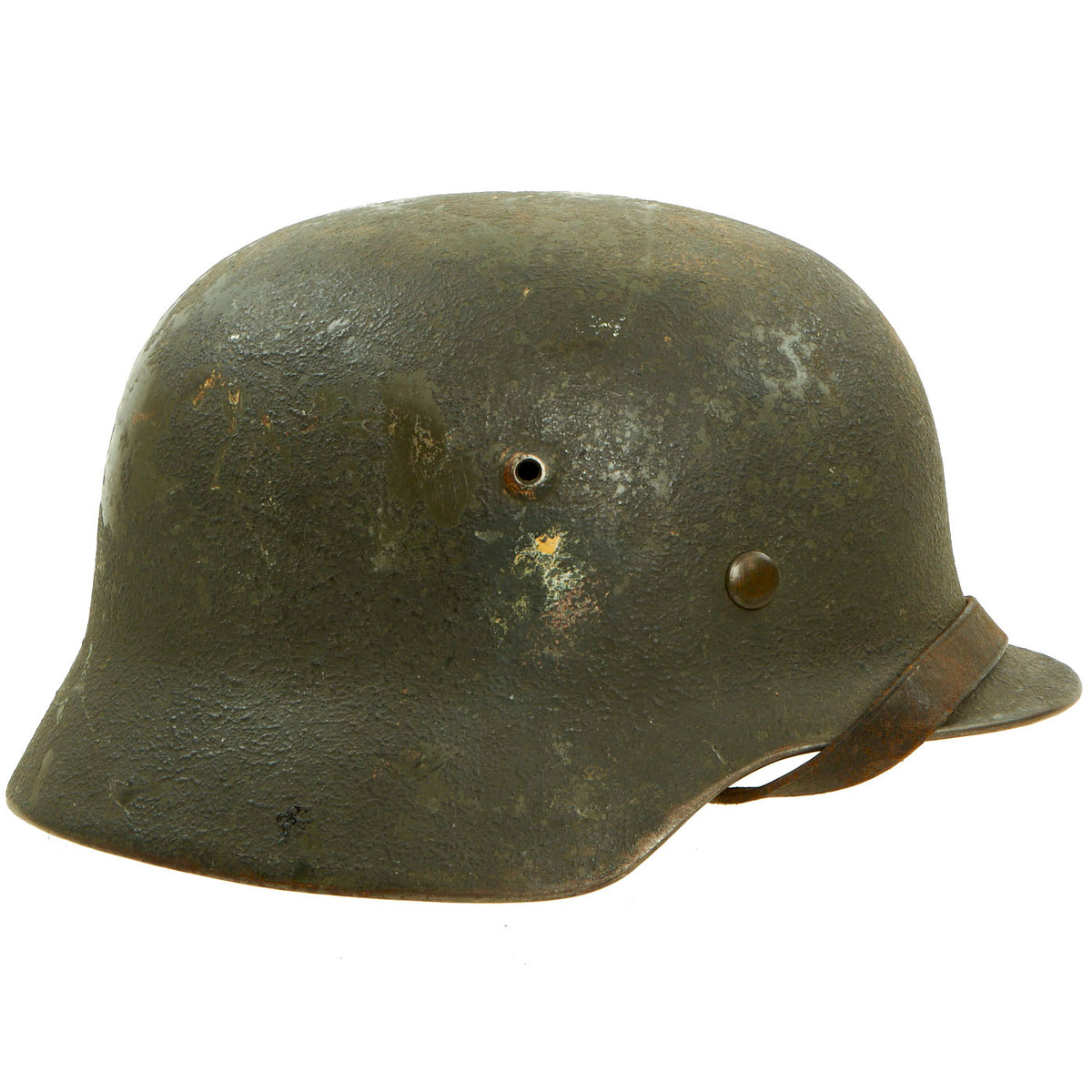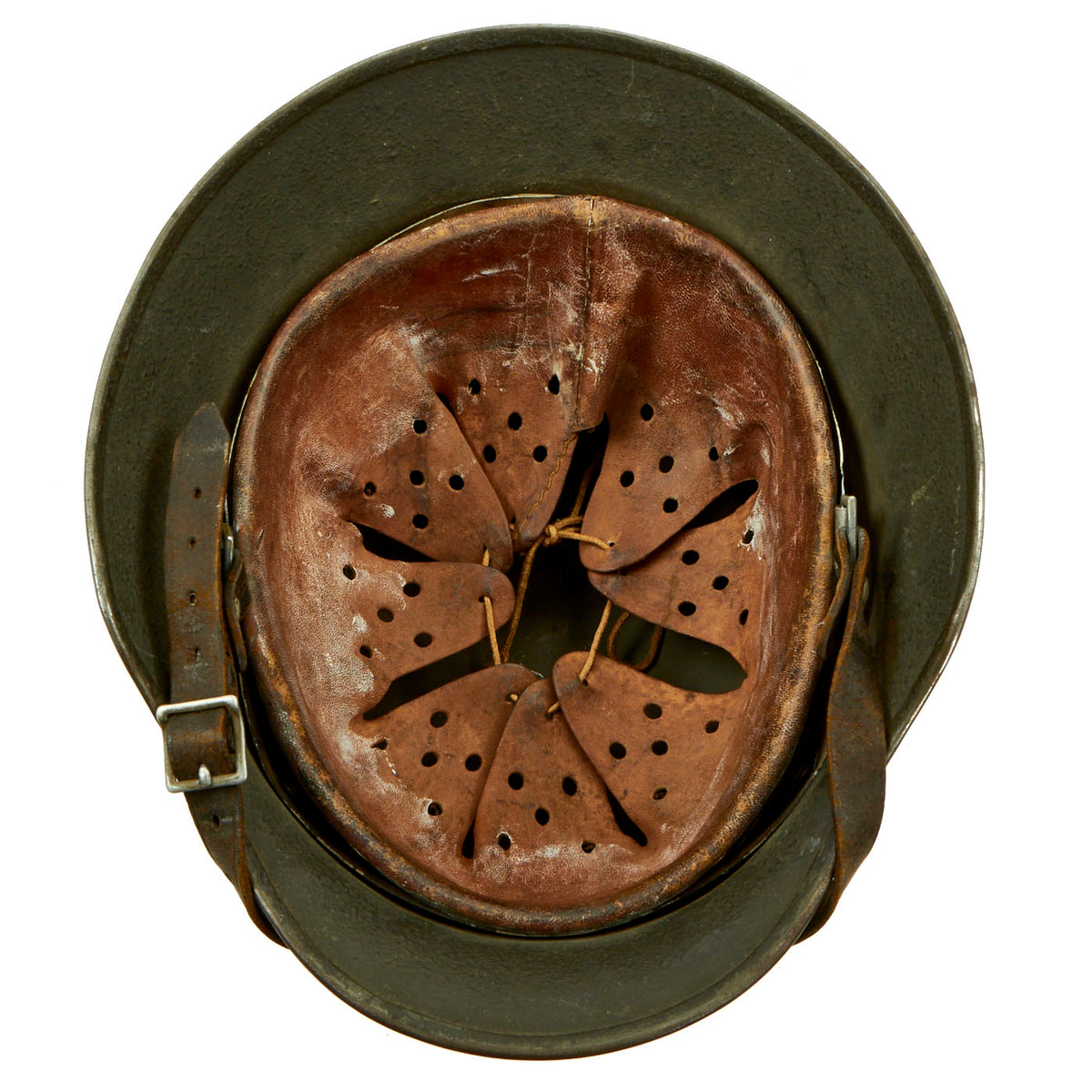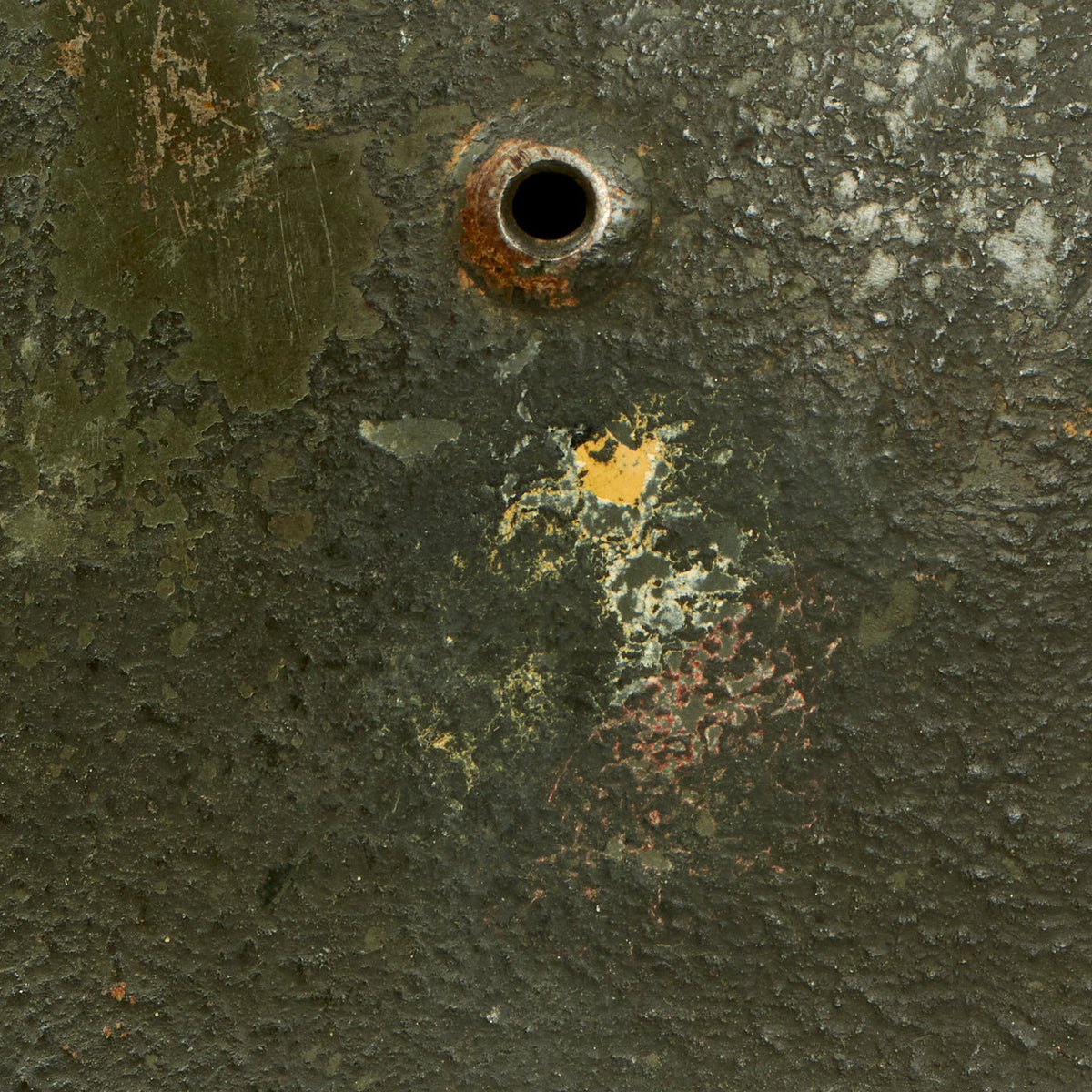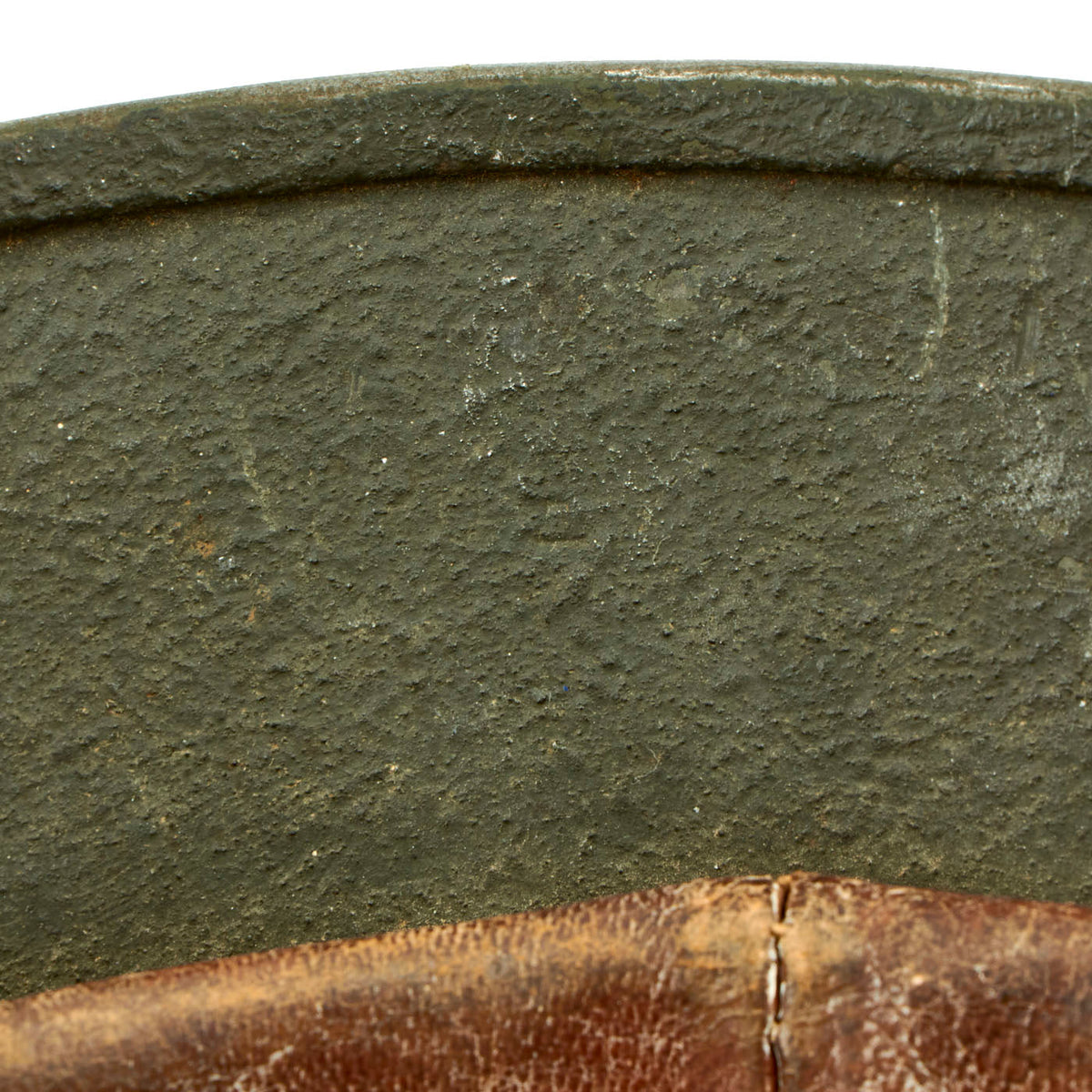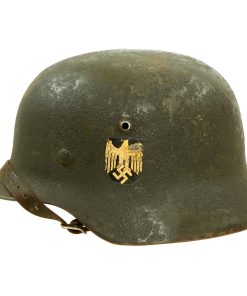Original German WWII Army Heer M35 Double Decal Textured Overpaint Helmet with 1937 dated 57cm liner & Chinstrap – Size 64 Shell Original Items
$ 2.195,00 $ 548,75
Original Item: Only One Available. This is a fantastic all original example of a German WWII M35 helmet, issued to the Heer (Army), which shows a fantastic look and patina. This stamped sheet steel construction helmet definitely shows signs of long service, As an early war helmet, it was originally painted with a very nice early Apfelgrün (apple green) paint, which is the early war color with more green in the mix. It also was affixed with very desirable “Double Decals” of a Silver Heer Eagle on the left side, and a “National Colors” decal on the right.
However, during its service life, the helmet was overpainted with a later war textured Feldgrau (Field Gray) color finish, which mostly covered the National colors, while the Eagle was protected from this. The use of the second decal had been discontinued in 1940, and in 1943 it was ordered that helmets with the national colors have them removed. As this example had the second decal overpainted and not removed, it was most likely repainted in the early 1940s.
It then saw much further service, which has worn away the textured overpaint in many areas, showing the original apple green paint underneath. There are also some areas where the paint is worn through to the steel. The Heer Eagle decal is probably still 70% visible, as the top and left edges were overpainted. The silver has faded to a nice “champagne” color, and still is bright and reflective, with some scratching overall. This is a really nice example of a service worn helmet with lots of patina!
When the helmet was overpainted, the textured paint was applied to the underside as well, in the standard “field repaint” style, which did not involve removing the liner. The original paint is still visible inside the dome. Unfortunately due to this, the stampings on the underside of the shell are completely covered up, except for just a bit on the rear skirt. We did measure it, and the shell measures about 65cm on the outside, so it is a 64cm shell. Size 64 is a nice smaller size that can accommodate liners from 56cm to 57cm or US 7 to 7 1/8. Size 64 shells are harder to find and are therefore more valuable to a collector.
All three of the original liner split pins are present, with the paint retained to a varying degree. They look to have brass heads (tested with a magnet), which is why one looks to be “brown” – it is oxidized brass. We see no evidence that they have ever been removed form the helmet. The interior of the helmet still has the original M31 leather liner with all eight of its fingers intact and an intact top strap. The leather is still supple, and shows only moderate wear, with no real degradation. The early war issue aluminum liner band is marked on the left outer side with 64 n.A. / 57, indicating that the liner is a size 57, intended for a 64 shell. The right side displays the full manufacture information, as well as a date:
D. R. P.
SCHUBERTH-WERKE
K.-G.
BRAUNSCHWEIG
1937
The band is the earliest pattern without reinforcements around the chin strap bails to support the chin strap. This liner is now somewhat deformed, as the chinstrap has pulled inward on the liner, bending the liner band as well as the band for the leather. This illustrates quite well why later liner bands had reinforced sides, and eventually were replaced with galvanized steel versions.
The original chinstrap is still intact and in very good condition, especially considering the age. There is no tearing or major deterioration, and it has the correct aluminum buckle and studs. You can see aluminum has rubbed off onto the chin strap where it is secured, so this chinstrap is definitely original and has bene on the helmet for some time. It even has a faded maker mark on the long end!
Overall a very nice 100% genuine M35 Double Decal Textured Overpaint Heer Army helmet! The period service wear on this gives it an absolutely unique look! This is an item that will only continue to appreciate in value over time!
The first “modern” steel helmets were introduced by the French army in early 1915 and were shortly followed by the British army later that year. With plans on the drawing board, experimental helmets in the field, (“Gaede” helmet), and some captured French and British helmets the German army began tests for their own steel helmet at the Kummersdorf Proving Grounds in November, and in the field in December 1915. An acceptable pattern was developed and approved and production began at Eisen-und Hüttenwerke, AG Thale/Harz, (Iron and Foundry Works), in the spring of 1916.
These first modern M16 helmets evolved into the M18 helmets by the end of WWI. The M16 and M18 helmets remained in usage through-out the Weimar Reichswehr, (National Defence Force, Circa 1919-1933), era and on into the early years of the Third Reich until the development of the smaller, lighter M35 style helmet in June 1935.
In 1934 tests began on an improved Stahlhelm, whose design was a development of World War I models. The Eisenhüttenwerke company of Thale carried out prototype design and testing, with Dr. Friedrich Schwerd once again taking a hand.
The new helmet was pressed from sheets of molybdenum steel in several stages. The size of the flared visor and skirt was reduced, and the large projecting lugs for the obsolete armor shield were eliminated. The ventilator holes were retained, but were set in smaller hollow rivets mounted to the helmet’s shell. The edges of the shell were rolled over, creating a smooth edge along the helmet. Finally, a completely new leather suspension, or liner, was incorporated that greatly improved the helmet’s safety, adjustability, and comfort for each wearer. These improvements made the new M1935 helmet lighter, more compact, and more comfortable to wear than the previous designs.
The Army’s Supreme Command officially accepted the new helmet on June 25, 1935 and it was intended to replace all other helmets in service.
The M1935 design was slightly modified in 1940 to simplify its construction, the manufacturing process now incorporating more automated stamping methods. The principal change was to stamp the ventilator hole mounts directly onto the shell, rather than utilizing separate fittings. In other respects, the M1940 helmet was identical to the M1935. The Germans still referred to the M1940 as the M1935, while the M1940 designation were given by collectors.
The last wartime upgrade to the standard helmet took place on 6 July 1942 at the request of the Army High Command. The rolled edge found on M1935 and M1940 helmets was discontinued as a measure of economy. On 1 August 1942 the first M1942 helmets were placed into production, and this was the model produced until late in the war, when most factories were captured or stood idle due to material shortages.
Fast Shipping with Professional Packaging
Thanks to our longstanding association with UPS FedEx DHL, and other major international carriers, we are able to provide a range of shipping options. Our warehouse staff is expertly trained and will wrap your products according to our exact and precise specifications. Prior to shipping, your goods will be thoroughly examined and securely secured. We ship to thousands clients each day across multiple countries. This shows how we're dedicated to be the largest retailer on the internet. Warehouses and distribution centres can be located throughout Europe as well as the USA.
Note: Orders with more than one item will be assigned a processing date depending on the item.
Before shipping before shipping, we'll conduct a thorough inspection of the items you have ordered. Today, the majority of orders will be delivered within 48 hours. The delivery time will be between 3-7 days.
Returns
The stock is dynamic and we cannot completely manage it because multiple stakeholders are involved, including our factory and warehouse. So the actual stock may alter at any time. It's possible that you may not receive your order once the order has been made.
Our policy is valid for a period of 30 days. If you don't receive the product within 30 days, we are not able to issue a refund or an exchange.
You can only return an item if it is unused and in the same state as the day you received it. You must have the item in its original packaging.
Related products
Uncategorized
Uncategorized
Angolan Rebel 1970s era 60mm Inert Display Mortar from Angolan Civil War Original Items
Uncategorized
Uncategorized
Uncategorized
Uncategorized
Armoured Fighting Vehicles of the World: AFVs of World War One (Hardcover Book) New Made Items
Uncategorized
Uncategorized
Uncategorized
Uncategorized
Australian WWII Owen MK1 Machine Carbine SMG Custom Fabricated Replica with Sling Original Items
Uncategorized
Uncategorized
Uncategorized
Uncategorized
Armored Burgonet Helmet & Polearm from Scottish Castle Leith Hall Circa 1700 Original Items
Uncategorized
